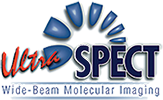Offer. Differentiation for suppliers now offering an integrated low-dose imaging in the supply chain.
The time is now to create a future where the delivery of care can continue smoothly, regardless of fluctuations and other happenings in the medical isotope market. The nuclear medicine industry is on the cusp of a positive chain reaction made possible as labs all over the country tap into solutions enabling low-dose and ultra-low dose imaging on NM exams. Radiopharmaceutical suppliers are no longer selling on price alone, but offering end users a safer solution. A solution that combines safety, value and added features with price.
Key Benefits
- Cost savings: By reducing the reliance on radiopharmaceutical isotopes such as molybdenum-99 (Mo-99), from which technetium-99m (Tc-99m) is produced, pharmacies can eliminate concern about pending price hikes now and in the future.
- Added cost savings: Less Tc-99m (or T1201) at each unit dose additionally cuts costs per unit dose by lowering the cost of generator profiles at pharmacies – enabling the ability to ration generators across sites, increase margins and profitability, and improve the ability of pharmacies to supply unit doses for rural areas.
- Safer imaging: By providing lower injected dose, patients are safer. The technologists administering the exams are safer. And you are enabling a higher standard in nuclear medicine imaging.
- Improved customer service: Healthcare organizations can now streamline the acquisition of UltraSPECT’s software through pharmacy providers as part of the supply agreement versus making a standard capital purchase directly from UltraSPECT.
- Uninterrupted patient care: Imaging departments can be assured of continued up-time and can stay on track with the patient schedule and critical exams. Because lower quantities of radioisotopes are needed, there is no impact from generator shutdowns for quality control to plant leaks that can result in shortages of important isotopes.
Did you know?
Radiogenic health effects (primarily cancer) have been demonstrated in humans through epidemiological studies only at doses exceeding 50–100 mSv delivered at high dose rates. Using the UltraSPECT solution, dose for a nuclear medicine exam can be as low as only 3 mSv.
What others are saying:
"When we present the UltraSPECT solution, healthcare facilities are amazed at everything they can achieve -- significantly reduced patient radiation exposure, improved patient throughput, no need for expensive camera upgrades, and all this while maintaining the high quality images cardiologists need for diagnostic accuracy. We believe these initial installations are just the start of a growing demand for the solution as all of our nuclear medicine customers see that everyone -- from patients and technologists to physicians, pharmacies and pharmacy staff -- will benefit."
Steve Chilinski, president and CEO, PharmaLogic.
“Wide Beam Reconstruction technology from UltraSPECT has been instrumental in our ability to maintain our high patient throughput throughout this technetium shortage. With our protocol of low-dose imaging, our business operations continue, and our patients are all imaged as planned and as needed. Few cardiovascular imaging facilities across the country can say the same.”
James Reibsane, CNMT, Director of Diagnostic and Technical Services at Berks Cardiologists LTD.
